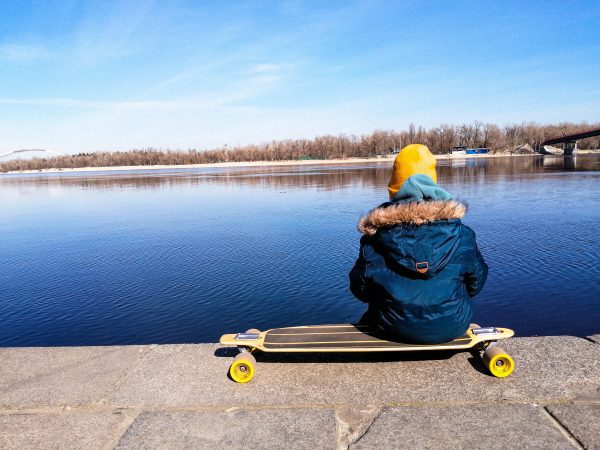As winter comes, skateboard enthusiasts face a unique set of challenges in keeping their boards at home in good condition. The frigid temperatures associated with winter can gradually exert a detrimental impact on the structural integrity of your board, which is why skateboarding in the winter can pose a threat to both your board’s immediate performance and long-term longevity.

To ensure that your skateboard in the winter will survive in the parking garages, it’s crucial to give some care to your skateboard in the winter months.
- In this article, we will walk you through essential tips and new tricks to winterize and maintain your longboard during the cold winter months.We’ve got you covered with practical advice to preserve the integrity of your longboard in cold weather, from cleaning and protecting the top deck, trucks, bearings, and other hardware. It would help if you did not skip any of these steps, as these can not only extend the life of your longboard but also enhance safety and performance while riding in winter-ravaged terrains.
Get ready to embrace skateboarding in the winter with confidence as we equip you with the knowledge to keep your longboard rolling smoothly through the frostiest, cold winter months of the year.
Key Takeaways
- Doing proper skateboard cleaning in the winter thoroughly before the cold season starts to remove dirt and debris.
- Inspect your skateboards for any damage and address issues promptly.
- Keep your skateboards dry in the parking garages and proper skateboard storage solutions and avoid skateboarding in the winter, or in wet or snowy conditions to prevent water damage and rust as these can damage your skateboard.
- Store your skateboards in cool, dry storage locations and storage solutions like parking garages, away from direct sunlight and extreme temperature fluctuations as this can damage your skateboard.
- Apply skateboard wax on the deck for added protection against moisture and road salt even when inside a freezing garage or your chosen storage solutions.
- Regularly clean and lubricate your bearings to prevent rust and maintain smooth performance when skateboarding in the winter.
- Check your trucks and hardware for rust or damage and replace in any worn-out components.
- Avoid riding on salted roads, as the salt can corrode the skateboard’s metal parts. Find a lot with enough space to support your riding needs and ensure safety.
- Stick to indoor skateparks and parking garages with a mini ramp instead of skateboarding in the cold weather.
- Consider using a skateboard cover when in parking garages or use a bag for transportation of your skateboard in the winter. Store your skateboard properly. When you store your skateboard properly in a proper skateboard storage, you are prolonging the life of your board.
- Clean and maintain your grip tape even when placed in a proper skateboard storage to retain grip on your skateboard in the winter season.
- Regularly inspect your skateboards for wear and tear even when inside parking garages throughout the cold season.
Impact Of The Winter In Skateboards
The cold weather can have several negative impacts on longboards, affecting various components and overall performance in the skate scene. Some of the effects of cold weather on a longboard include:
- Deck Damage: The cold temperatures can cause the skateboard deck to become more brittle. This makes it more susceptible to cracking or snapping, especially if subjected to heavy impacts or landing tricks with force. Additionally, extreme temperature fluctuations between cold outdoor weather and warm indoor environments can lead to the wood expanding and contracting, potentially causing warping or delamination. This is why it is important to store your skateboard properly in proper skateboard storage.
- Decreased Flex: Skateboard decks are designed to have a certain amount of flex, which can affect the board’s pop and response. In colder temperatures, the deck’s flexibility can be reduced, leading to a stiffer ride and less pop during tricks.
- Bearing Performance: Cold weather can affect the lubrication of skateboard bearings. Grease and oil in the bearings may thicken or harden, leading to increased friction and reduced performance. This can result in slower and less smooth rides.
- Truck Issues: The cold weather can affect the performance of skateboard trucks. Metal components can contract, potentially leading to issues like squeaky or less responsive turning.
- Grip Tape and Shoes: Cold and wet weather can affect the grip of the skateboard’s grip tape and the grip of shoes on the board. Moisture can reduce the friction between the shoes and the grip tape, making it harder to maintain control during tricks and maneuvers.
- Corrosion: If you ride your skateboards in areas where roads are salted during the cold season, the salt can lead to corrosion of metal parts, such as bearings, trucks, and hardware.
- Moisture Damage: Moisture from rain, snow, or slush can seep into the skateboard’s components, leading to rust, rot, and damage over time. Store your skateboard in proper skateboard storage.
- Reduced Performance: Overall, the cold weather and its impact on the skateboard’s components can lead to reduced performance in the skate scene, making skateboarding less enjoyable and hindering the ability to perform tricks effectively.
To mitigate these effects and repair your longboard performance during the cold season, it’s essential to take extra care, keep the longboard dry, and follow proper maintenance routines. This will also save you time and money to spend in skate shops. Avoiding extreme weather conditions and storing the longboard in a cool, dry place when not used can help your longboard prolong its life and ensure a smoother riding experience once the warmer seasons return. Stick to a close, indoor skatepark during the cold months if you can.

Skateboards In Wintertime
Keeping your longboard during the cold weather is essential to keep in good condition and ensure safe riding. Midwinter weather can be harsh on your longboard, so here are some tips to help you properly winterize and maintain your skateboard in the winter.
- Clean the skateboard: Before the cold season starts, thoroughly clean your skateboard. Use a damp cloth or a mild soap solution to remove dirt, grime, and any debris that may have accumulated during your rides.
- Inspect for damage: Check your skateboard for any signs of wear and tear in the wheels and other skateboard hardware, such as cracks, chips, or loose parts. Address any issues before they worsen during cold season riding conditions.
- Keep it dry: Moisture is the enemy of your skateboard bearings and wood. Avoid riding your skateboard in wet or snowy conditions, as water can damage the deck, trucks, and other hardware, and it can also rust the bearings. If your board gets wet accidentally, dry it off immediately.
- Skateboard Storage – Store your skateboard properly: When not in use, your skateboard storage should be a cool, dry place away from direct sunlight. Avoid skateboard storage areas with extreme temperature fluctuations and bad weather, as this can cause the wood to warp.
- Apply wax to the deck: You may get your wax from your favorite online shop. Applying a coat of board wax on the deck can help protect it from moisture and water damage. It also adds a bit of protection against salt and sand on the roads during the cold season.
- Protect the bearings: Keep your bearings clean and lubricated during the cold season. Regularly check for dirt and grime buildup. If you ride in wet conditions, consider investing in some waterproof bearing lubricant to help prevent rust.
- Check trucks and hardware: Inspect your deck, trucks, and hardware regularly for any signs of rust or damage. Replace any rusty or worn-out components promptly.
- Avoid salted roads: In areas where roads are salted during the cold season, avoid riding on them as the salt can corrode the skateboard’s metal parts.
- Use a skateboard cover: If you need to transport your board during cold season, consider using a board cover or a bag to protect it from the elements.
- Winterize grip tape: To maintain your grip while skateboarding in the cold season, you can use grip gum or grip tape cleaner to remove dirt and debris from your grip tape.
- Regularly check for wear and tear: Riding in cold weather, especially in the snow, can be tough even on the best skateboards. Make sure to check your board more frequently for any signs of damage, even if it’s stored in a skateboard storage area, and address any issues promptly to stay safe in the skate scene.
- Remember, prevention is key when it comes to keeping your longboard during the wintertime. By taking the necessary precautions and regularly inspecting and cleaning your street surfing longboard, you can ensure it stays in good condition and is ready to ride once spring arrives. Have fun and skate safely!
Please share thoughts and feedback with us and on your social media accounts about this article so we can continue to provide you with quality content about skateboarding.
Conclusion
The winter can be a challenging time for street surfers as the midwinter poses various risks to the performance and longevity of their beloved boards. This is evident even in social media. However, with proper care and maintenance, you can navigate through the winter months without compromising board’s condition.
- Regularly inspecting your longboard for signs of wear and damage, keeping it clean and dry, and storing it in a suitable environment are essential steps to protect it from the harsh elements. Applying wax to the deck, lubricating the bearings, and checking the trucks and hardware can go a long way in preserving your street surfing board functionality.
Remember, prevention is key. Avoid riding wet or salted roads, and opt for indoor skate parks in extreme weather conditions. By taking precautions and staying attentive to longboard needs, you can ensure it remains winter-ready and primed for action once the warmer days return.
So, embrace the midwinter longboard challenge with confidence, armed with the knowledge and practice to maintain a longboard to a top-notch shape. Let your passion for street surfing thrive all year round, as you roll smoothly through the obstacles and continue to enjoy the exhilarating sport you love. Stay safe, and happy street surfing!

Frequently Asked Questions (FAQs)
Last Updated on July 6, 2024 by Inma Barquero
DISCLAIMER (IMPORTANT): This information (including all text, images, audio, or other formats on FamilyHype.com) is not intended to be a substitute for informed professional advice, diagnosis, endorsement or treatment. You should not take any action or avoid taking action without consulting a qualified professional. Always seek the advice of your physician or other qualified health provider with any questions about medical conditions. Do not disregard professional medical advice or delay seeking advice or treatment because of something you have read here a FamilyHype.com.